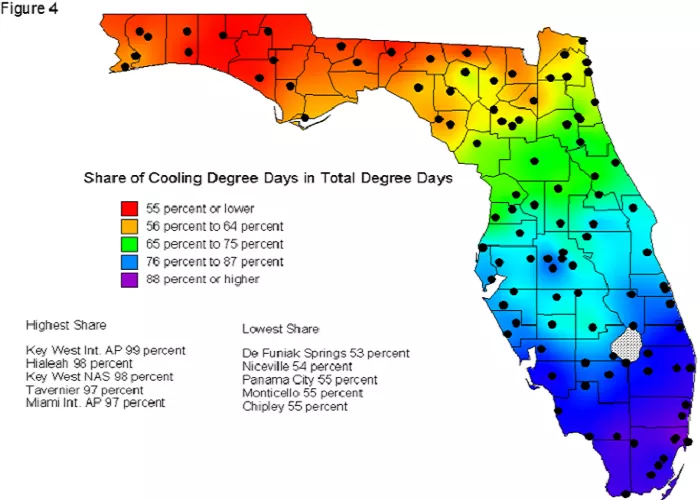Florida, often referred to as the Sunshine State, is renowned for its warm and sunny climate. Its geographical location, bordered by the Atlantic Ocean and the Gulf of Mexico, contributes to its consistently high temperatures throughout the year. However, certain months stand out as particularly hot. Understanding these patterns is essential for residents and visitors alike to prepare for the intense heat.
Average Monthly Temperatures in Florida
Florida’s climate varies slightly between regions, but generally, the summer months are the hottest. Here’s a breakdown of average high temperatures for key cities:
| Month | Miami (Southeast) | Tampa (West Coast) | Orlando (Central) | Jacksonville (Northeast) |
|---|---|---|---|---|
| January | 74°F (23°C) | 70°F (21°C) | 72°F (22°C) | 68°F (20°C) |
| February | 75°F (24°C) | 71°F (22°C) | 73°F (23°C) | 69°F (21°C) |
| March | 77°F (25°C) | 73°F (23°C) | 75°F (24°C) | 72°F (22°C) |
| April | 79°F (26°C) | 75°F (24°C) | 77°F (25°C) | 74°F (23°C) |
| May | 82°F (28°C) | 78°F (25°C) | 80°F (27°C) | 77°F (25°C) |
| June | 86°F (30°C) | 82°F (28°C) | 84°F (29°C) | 81°F (27°C) |
| July | 88°F (31°C) | 85°F (29°C) | 87°F (31°C) | 84°F (29°C) |
| August | 88°F (31°C) | 85°F (29°C) | 87°F (31°C) | 84°F (29°C) |
| September | 87°F (31°C) | 84°F (29°C) | 86°F (30°C) | 83°F (28°C) |
| October | 84°F (29°C) | 80°F (27°C) | 82°F (28°C) | 79°F (26°C) |
| November | 79°F (26°C) | 75°F (24°C) | 77°F (25°C) | 73°F (23°C) |
| December | 76°F (24°C) | 72°F (22°C) | 74°F (23°C) | 70°F (21°C) |
Note: Temperatures are approximate averages and can vary annually.
July: The Peak of Florida’s Heat
Analyzing the average temperatures, July emerges as the hottest month across Florida. Cities like Miami, Tampa, Orlando, and Jacksonville consistently record their highest temperatures during this month. This trend is attributed to several factors:
- Solar Intensity: In July, the Northern Hemisphere is tilted towards the sun, resulting in longer days and more direct sunlight, which elevates temperatures.
- Atmospheric Conditions: The combination of high-pressure systems and increased humidity during July contributes to the sustained heat.
Rising Temperatures and Climate Change
It’s important to note that Florida has experienced a trend of rising temperatures over the past decades. Recent years have seen record-breaking heat:
- Tampa Bay: In July 2023, Tampa Bay recorded its hottest month on record, with an average temperature of 86.5°F, surpassing the previous record of 86.3°F.
- Statewide Observations: July 2022 marked the hottest month in Tampa’s history since records began in 1890, with an average temperature of 86.3°F.
These observations highlight the impact of climate change, leading to more frequent and intense heatwaves. Projections suggest that above-average temperatures may persist, affecting various regions differently.
Health Implications of Extreme Heat
The increasing frequency of high-temperature months like July poses significant health risks:
- Heat-Related Illnesses: Prolonged exposure to high temperatures can lead to heat exhaustion, heatstroke, and dehydration.
- Vulnerable Populations: Outdoor workers, the elderly, and those without access to adequate cooling are at heightened risk.
In Florida, outdoor workers face severe heat-related health risks, with reports of fainting, nausea, and even death due to inadequate water and shade provisions.
Mitigating the Effects of Heat
To combat the challenges posed by extreme heat, several measures are recommended:
- Stay Informed: Regularly check weather forecasts and heat advisories.
- Hydration: Consume ample water throughout the day, especially during outdoor activities.
- Appropriate Clothing: Wear lightweight, light-colored, and breathable fabrics.
- Limit Outdoor Exposure: Avoid strenuous activities during peak heat hours, typically between 10 a.m. and 4 p.m.
- Seek Cooling Centers: Utilize air-conditioned public spaces during extreme heat periods.
Conclusion
July stands as the hottest month in Florida, characterized by elevated temperatures and heightened humidity. Recognizing this pattern is crucial for implementing health and safety measures. As climate change continues to influence weather patterns, understanding and adapting to these changes will be essential for the well-being of all Floridians.

